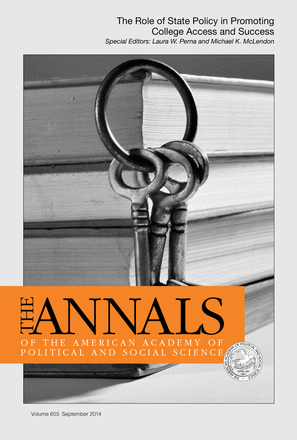 Academic Funding
Academic Funding The Perverse Results of Performance Funding for Universities

This article is drawn from a paper published in the September 2014 issue of The ANNALS of The American Academy of Political and Social Science. For a limited time, read the ANNALS article for free by clicking here.
Historically, oversight of higher education has been oriented toward regulating inputs and procedures, but over the last few decades policymakers have increasingly demanded that universities be held accountable for their performance, particularly with respect to undergraduate student outcomes. The average public four-year college in the United States graduates less than 60 percent of its students in six years, and graduation rates for many racial/ethnic minority groups are much lower. As student outcomes have continued to lag at public colleges and universities, there has been a significant shift in the way that many people think about the need for accountability and transparency with regard to higher education.
Performance funding, initially adopted in 1979 by Tennessee, became increasingly popular during the 1990s as a number of states began to implement a wide range of results-oriented reforms. When states felt the impact of a series of economic recessions during the mid-2000s, performance funding (which often centered on awarding bonus funding) waned in popularity, and several states dropped the performance component of their funding criteria. In the last few years, however, these policies have reemerged, largely due to the efforts of reform-oriented organizations such as Complete College America and the Bill and Melinda Gates Foundation (see the figure below).
At the center of calls for accountability are normative debates about the proper role of quantifiable data about institutional performance and the appropriateness of various approaches for measuring and tracking student success. Recent performance funding policies have been quite controversial. Proponents claim that funding incentives will spur increased performance by providing universities with stronger incentives to focus on and improve student outcomes. Critics, however, worry that these initiatives will negatively impact academic quality and rigor, that they might stifle efforts to improve diversity and provide broad access, or that they may simply be ineffective and divert attention and resources away from other reforms that would be more effective.

This article by Amanda Rutherford and Thomas Rabovsky originally appeared on the LSE USAPP – American Politics and Policy blog as “Performance funding policies in higher education have had little effect on student outcomes” and is reposted under the Creative Commons license (CC BY 3.0).
Studying U.S. postsecondary institutions across 18 years, we find that performance funding policies are generally unrelated to graduation rates. Further, the length of time a performance funding policy has been in place may actually cause additional declines in graduate rates–.016 percentage points per year on average. Additional analyses show the same negative trend for retention rates and degree production.
We then tested whether different types of performance funding policies have similar effects on student performance. Older “performance funding 1.0” policies (PF 1.0) can differ dramatically from newer “performance funding 2.0” reforms (PF 2.0). For instance, many PF 2.0 policies focus on intermediate indicators of campus performance (throughput), rather than output/outcome indicators. In theory, this should provide policy-makers and campus officials with more actionable and relevant information about performance, which can then be used to inform new programs or to improve existing approaches. Because 2.0 policies are designed to be more comprehensive and substantive than the older 1.0 policies, some have argued that PF 2.0 policies will be more effective.
Our results provide some support for this logic. Analyses show that the negative relationship between performance funding and graduation rates exists for 1.0 policies only. Although not significant, the coefficients for 2.0 policies are positive (see the predicted probabilities in the figure below). While many 2.0 policies have only been in place for a few years, it may be that 2.0 policies have evolved enough from 1.0 policies to have some effectiveness in prompting colleges and universities to improve student performance. Performance 1.0 and 2.0 policies have little effect on retention rates, but do have interesting dynamics in the case of degree production. Though substantively small, 1.0 policies appear to negatively affect performance over time while 2.0 policies may improve performance over time.
Performance funding policies in place between 1993 and 2010 appear to have very little direct effect on student outcomes, despite the expectation that institutions will react to funding incentives by prioritizing student success. These findings illustrate that student outcomes are not enhanced by performance funding policies. Moreover, student outcomes may even decline following the adoption of these policies. At best, these policies are ineffective, and, at worst, they are negatively linked to student performance. However, performance 2.0 policies may provide some hope that policies linked to institutional base funding may produce long-term improvement. Although a positive relationship was detected for only one performance indicator and was small in size, it is possible that the incentive structures of 2.0 policies are effective in gradually increasing student performance if these policies continue over time.
The rise of PF 2.0 policies may provide useful insights for those hoping to design effective accountability regimes in other policy areas. Because PF 2.0 policies involve larger percentages of base funding, they are likely to attract more attention from administrators. Similarly, as it has become more apparent that performance funding policies are spreading to more states and are likely to be in place for the foreseeable future, institutions may be less likely to discount the commitment of policy-makers to performance funding and may be more likely to respond to performance goals. This view suggests that strong financial incentives, combined with long-term stability, are the most important elements of effective accountability policies. An alternative interpretation, however, might focus on the fact that these newer policies also often use intermediate outcomes and take a more comprehensive view of performance assessment. Thus, issues of policy design related to the relevance and perceived legitimacy of performance data, as opposed to stronger financial incentives, may be critical in creating conditions that enable effective performance management.




























































































